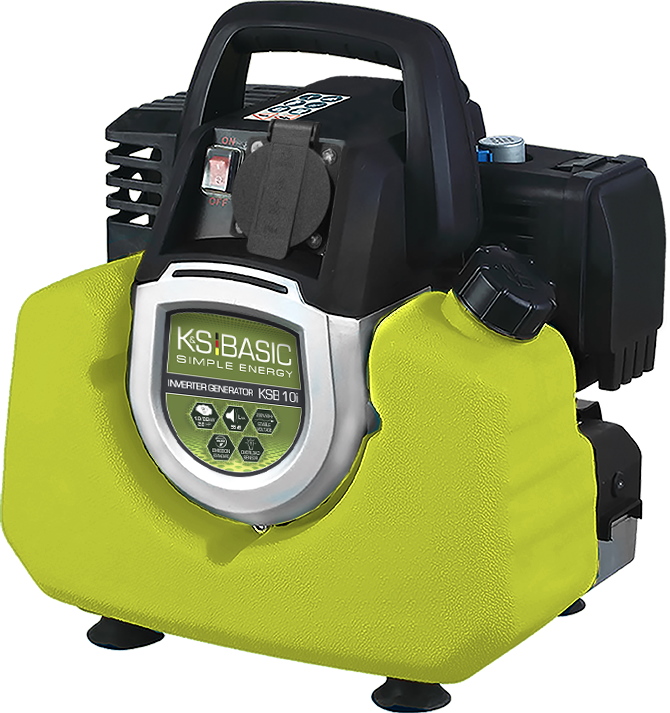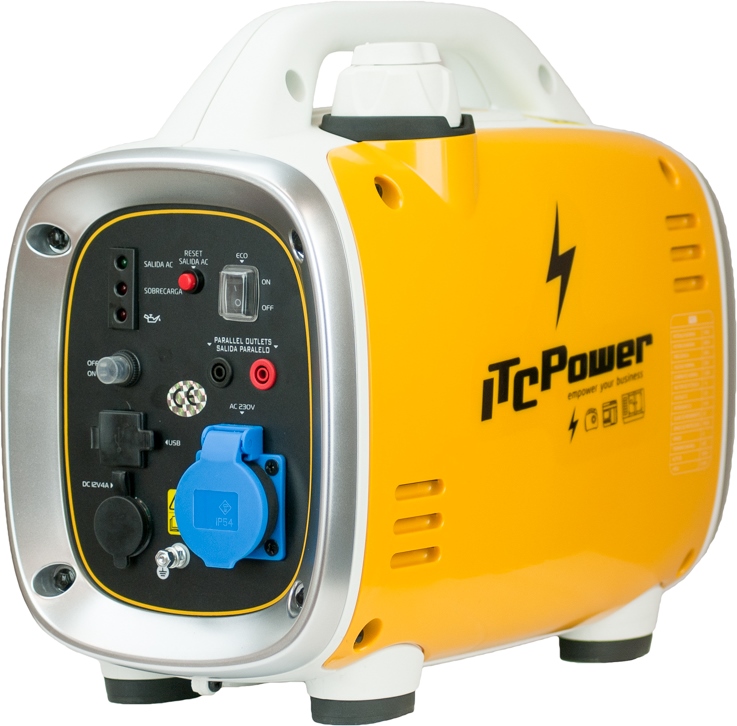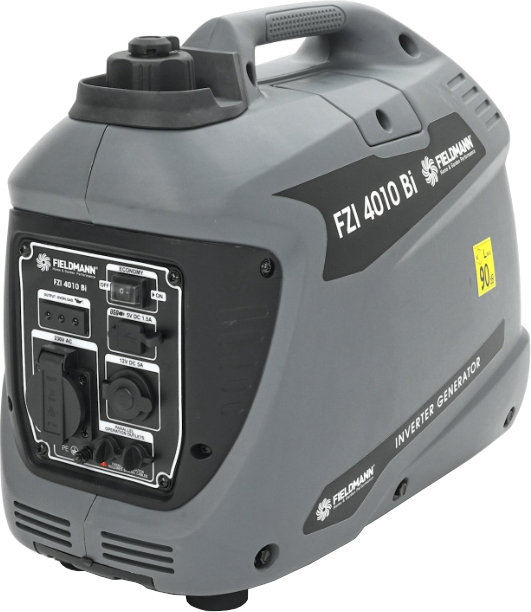TOP 5 small generators with power up to 1 kW

A summary table with the characteristics of the generators will allow you to quickly compare all five devices included in our selection. Other generator sets ( gasoline, gas-gasoline and diesel) can be found in the corresponding sections of the power station catalogue. If you don’t know what functions and characteristics you should pay attention to, you should read the article “How to choose a backup power supply generator,” which describes in detail the main points and key nuances.

A simple and inexpensive power station KRAFT&DELE KD109 is designed to serve low-power consumers. In the nominal operating mode, it “pulls” a load of 0.8 kW (in a short-term mode it can withstand 1.2 kW). That is, you can connect to this generator either a small grinder or drill, or a “garland” of a dozen not very bright incandescent light bulbs, but not all of the above at once. However, no one expects more from a small and such a cheap generator.
This device uses a two-stroke engine with a power of two “horses” and a working volume of 63 cm3 as the power plant. This solution has both advantages and disadvantages. On the one hand, 2T motors are simple, cheap and can be easily repaired. But two-stroke gas generators are less convenient to operate than four-stroke ones. For example, owners of KRAFT&DELE KD109 need to refuel the power station not with pure gasoline, but with fuel pre-mixed with special oil in a ratio of 50:1. And you will never achieve truly quiet operation from a two-stroke, despite the low engine power. But in terms of gasoline consumption, this engine has very moderate “appetites.” The manufacturer claims that the gas generator consumes no more than 0.4 liters of fuel per hour of operation. Therefore, a 4.2-liter gas tank should be enough for at least 10 hours of autonomous power supply.
Electricity is generated by a synchronous alternator with an autovoltage regulator (AVR), which prevents too sharp “jumps” and deep “dips” in voltage at moments when the load on the generator changes. The user can control the output current parameters using an analog voltmeter with an arrow (this is the only device on the front panel, and multifunctional digital displays are practically never found in equipment of this class). To connect AC consumers, you can use a single socket (230 V, 16 A). Next to it there is also a connector for powering low-voltage devices operating on direct current (12 V). It can be used to recharge car batteries (the necessary cables with a plug corresponding to the connector are included in the kit).

| Tehnopostavka.com.ua | 5 300 ₴ | To Store |
| Rozetka.ua | 4 298 ₴ | To Store |
| Rozetka.ua | 5 200 ₴ | To Store |
| Rozetka.ua | 4 428 ₴ | To Store |
| Rozetka.ua | 6 990 ₴ | To Store |
The small single-phase household power station Tagred TA980 is a compact “cube” measuring 380x320x320 mm. It weighs 16.5 kg, so it is considered a relatively light generator (it can be lifted and moved from place to place by one adult). All components and assemblies necessary for autonomous electricity production are mounted on a tubular frame: a 2.1 hp motor. (with manual start), synchronous alternator, 4-liter gas tank (with fuel level indicator) and instrument panel with connectors, circuit disconnect buttons, voltmeter and warning light. The engine on the generator is two-stroke. It's as simple as two fingers, but noisier and smellier than any four-stroke. It should be remembered that 2T engines are not refueled with pure gasoline directly from a canister, but with a gasoline-oil mixture, which must be pre-prepared. However, anyone who has previously encountered brush cutters, gasoline lawn mowers, chainsaws, walk-behind tractors or outboard motors is well acquainted with this procedure.
This generator is designed to serve a load of up to 0.98 kW (in short-term mode - up to 1.25 kW). That is, he will not be able to provide electricity for the entire house. But it can at least be used to drive some (not very powerful) power tools or power a couple of table lamps and laptops, as well as recharge cell phones and power banks. It can also be useful for heating if you have a small fan heater, infrared heater or electric blanket. In addition to one regular 230 V socket, there is a low-voltage connector on the front panel of the generator, which is designed for recharging 12-volt car batteries (the cables with crocodile clips required for this are included).
There is no doubt that the Tagred brand is not particularly well-known, and power plants with this inscription are not considered something particularly outstanding. But if you don’t care about fat, but just need to buy an inexpensive generator with a power of around 1 kW, then the Tagred TA980 is a good option. At least, it doesn’t have many competitors in the low-cost segment. For the same price, you can only buy less powerful (650-watt) HECHT GG 950DC and Hyundai HG800-3 devices or some models from the KRAFT&DELE line of generators.

| Instrumentarium.com.ua | 9 899 ₴ | To Store |
| A-Trade.com.ua | 9 899 ₴ | To Store |
| Storgom.ua | 9 899 ₴ | To Store |
| Generator.ua | 9 899 ₴ | To Store |
| PermyCo | 9 899 ₴ | To Store |
Despite the fact that the Konner&Sohnen Basic KSB 10i belongs to the “basic” line of generators (it even differs in color from other power plants of the same brand), it has one interesting feature that is not at all typical of “state employees”. We are talking about an inverter alternator with a copper winding - a unit that generates electricity. Alternators made using inverter technology are distinguished by their ability to generate “clean” current with stable characteristics even when the connected load changes. The manufacturer claims that the voltage produced by this generator never differs from the standard 230 V by more than 5%. This is probably why the device is not equipped with even a simple voltmeter. Its entire “set of devices” consists of one light bulb, the only function of which is to promptly inform the user that the load connected to the power plant exceeds the rated one (0.8 kW).
There are no other “high technologies”, except for the inverter alternator, in the design of this generator. It is equipped with a 43 cc engine with 2 hp. This is a two stroke engine. Therefore, the user needs to be prepared for the fact that before filling the tank, gasoline will have to be mixed in a canister with special motor oil in exactly a certain proportion (50:1). Another unpleasant feature of the 2T engine is that it is impossible to achieve quiet operation from it (despite the low motor power). Moreover, this power plant does not have any sound insulation. For example, the Konner&Sohnen Basic KSB 12i S generator, although more powerful, is much quieter thanks to its four-stroke design and closed casing.
The engine is started manually using a cable. The motor is moderately “gluttonous”. The manufacturer claims that a 3.5-liter gas tank filled to capacity is enough for approximately 5.4 hours of operation (at a load of 50% of the rated load). Without fuel, the generator weighs only 8.5 kg - very little even by the standards of portable power plants. Of the connectors, it has only one socket, so when buying a generator it is better to immediately buy an extension cord or tee.
It should be noted that the Konner&Sohnen Basic KSB 10i generator is generally a good device, but by no means unique. It has many “twins”: Yato YT-85481, KRAFT&DELE KD132, Sealey G1000I, Proton BG-1000i, FUBAG BS 1000 I, Auron Mini, BISON BS900Q, QINLONG QL1000i, GEOTECH MG1000i, GARLAND Bolt 110i, etc. They among themselves They are no different except for the colors and stickers with brand names. The existence of a whole galaxy of identical generators clearly shows how popular this format of power plants is (compactness, portability, power within 1 kW plus an inverter alternator), and how favorable their price-performance ratio is.

The ITC Power GG9i generator is a miniature and very light equipment (it weighs only 9.3 kg - just “fluff” by the standards of such devices). Typically, design is not a priority for power plants (many manufacturers do not fool themselves with such things, releasing to the market the most faceless generator sets with an unassuming appearance). But in this case, ITC Power did their best and made an elegant case with graceful contours for the generator. It has not only an aesthetic, but also a utilitarian function, as it is a soundproof casing that absorbs sounds produced by the parts and mechanisms of a mini-power plant. As a result, the noise (at a distance of 7 m from the operating device) does not exceed 58 dB - this is quieter than the volume of a normal conversation. Therefore, the ITC Power GG9i generator is considered very quiet.
Inside the case there is a four-stroke gasoline engine (1.4 hp) and an inverter alternator responsible for producing electric current. Thanks to inverter technology, the installation generates a current with a “correct sinusoid”, the characteristics of which always correspond to the specifications (230 V, 50 Hz), even with a “jumping” load. This is extremely important if you plan to use a generator to ensure autonomous operation of capricious equipment, such as gas or solid fuel boilers with modern automation, as well as powering consumer electronics, such as a computer or TV. To connect consumers, the following are provided: one 230 V socket, a 12 V DC connector and a USB port. The front panel of the device also has connectors for parallel connection (with a pair of generators, cables and a special device, which is sold separately, you can combine two power plants into a single system to operate on a common load).
Exactly the same generators can be found on sale under other names: Black&Decker BXGNI900E, Hyundai HY900Si or Weekender GS950i. All of them are produced at the same plant (one of the subsidiaries of ITC Power) and practically do not differ from each other except for color. But, since Black & Decker and Hyundai generators are more well-known and “promoted,” online stores ask for them a little more than for analogues from ITC Power.

| Davi.com.ua | 15 299 ₴ | To Store |
| Ebox24.biz | 13 640 ₴ | To Store |
| Ok24.biz | 13 981 ₴ | To Store |
| Wow24.biz | 14 322 ₴ | To Store |
The Fieldmann FZI 4010-Bi mini-power station is designed to serve a load with a total power of up to 0.9 kW. Its “heart” is a four-stroke gasoline engine with a displacement of 54 cubic centimeters. Despite the absence of an electric starter, the engine starts easily and confidently thanks to the transistor ignition system. In size (505x310x430 mm) and weight (15 kg), the Fieldmann FZI 4010-Bi approximately corresponds to a 20-liter canister filled with gasoline (which, of course, you should also have on hand, because the gas tank holds no more than 3 liters of fuel). That is, an adult should be able to lift and carry this generator alone without any problems.
This generator uses an inverter type alternator. This technical solution has several important advantages. Firstly, inverter alternators generate current with a “correct sinusoid” and stable characteristics (modern computer and household appliances do not tolerate voltage surges and dips well). From this point of view, the Fieldmann FZI 4010-Bi is an excellent option if you need to buy a good generator to power consumer electronics or automation that ensures the operation of heating equipment). Secondly, thanks to inverter technology, the power plant has an “economy mode” (turned on by a separate button), in which the engine, flexibly adapting to the changing load, consumes less fuel. When operating in normal mode (serving a load equal to the nameplate 0.9 kW), a full tank of fuel is enough for 4.5 hours of autonomous operation, and with the “eco” button turned on and a reduced load, the same tank can be “stretched” for 8.5 hours (at least this is what the Czech manufacturer assures when advertising its Fieldmann generators).
The set of outputs is more or less standard for this class of power equipment. Users have access to a socket (230V), a DC socket (12V) and a USB port. A nice “bonus” to all of the above are connectors that allow (with a special device and cables) to connect a pair of identical power plants in parallel to operate on a common load. But what’s not encouraging is the price, it’s a little high, like for a generator that doesn’t even reach 1 kW, because there are cheaper devices on sale. But, hand on heart, we must admit that other good manufacturers have power plants of the same power class with similar characteristics and equipment that cost no less (for example, Hyundai HHY1050Si), and for high-quality companies - even more (for example, the legendary generator Honda EU10i).
Articles, reviews, useful tips
All materials


































